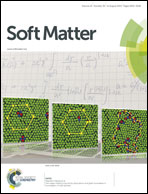Swelling enhancement of polyelectrolyte brushes induced by external ions†
Abstract
It has been observed previously that when permanently charged polyelectrolyte brushes are exposed to an external salt solution, they shrink when the salt level is high enough. In this study, we observed an enhanced swelling process before the salt concentration reached that limit. We systematically investigated a few strong polyelectrolyte brush systems, including sodium polystyrene sulfonate (PSSNa), poly([2-(methacryloyloxy)ethyl] trimethylammonium chloride) (PMETAC) and potassium poly(3-sulfopropyl methacrylate) (PSPMA) with different molecular weights and grafting density using a combination of methods, including ellipsometry, quartz crystal microbalance with dissipation (QCM-D) and atomic force microscope (AFM). The swelling enhancement is expressed by the thickening of the brush layer at moderate salt concentrations, accompanied by the decrease of refractive index, the increase of the amount of solvent inside the brushes and an increase in retardation time. A scenario is proposed in which the counterions penetrate into the brushes driven by the external salt ions, they disrupt and break up the previously formed multiplets due to the dipole–dipole interaction by the ion-pairs on the polymer chain. This process results in the release of the bound segments and the stretching of the polymer chains.


 Please wait while we load your content...
Please wait while we load your content...